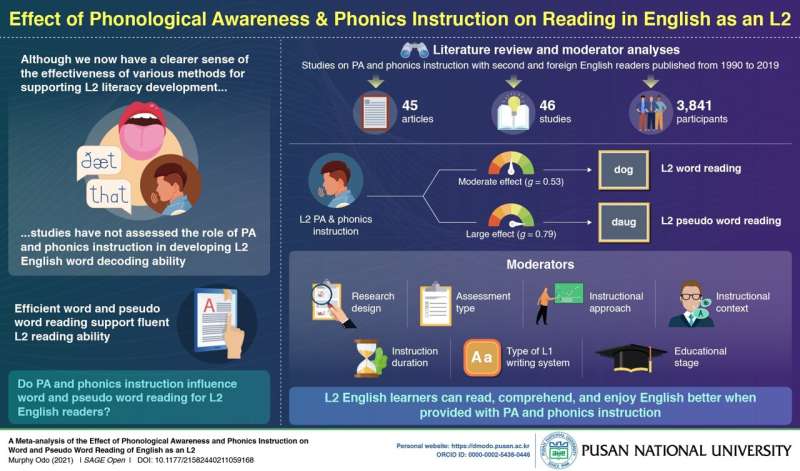Perceiving sound-letter associations in English can help people learn to read it better

Learning to read in English is not just about using context (e.g., pictures) to guess the meaning of the words on the page but also about being aware of the sounds in words and their use. This ability, called "phonological awareness" (PA), is the foundation of learning how to read in an alphabetic language like English. Traditionally, L2 (second and foreign language) reading has not focused on using PA or phonics (teaching based on correlation of sounds with symbols) but instead on memorizing whole words or guessing the word from context. However, a growing number of experiments have shown that an understanding of the individual sounds in a word and their correspondence to letters is necessary to develop the ability to read and decode words in an L2.
English is the most widely learned L2 around the world. One of the things most non-native English speakers struggle with is learning to read English words. This is related to a lack of PA and, therefore, PA and phonics instruction can be of great help in improving their perception of the individual sounds in English words and linking those sounds to the letters of English to sound out new words learners meet while reading. However, it is not clear if PA and phonics instruction can help develop print decoding skills which is the ability to read English words that they have never seen before.
In a recent study, Prof. Dennis Murphy Odo from Pusan National University conducted a meta-analysis of research published in the past 30 years i.e. from 1990 to 2019, to assess the significance of PA and phonics instruction in learning to decode English as a second language. Prof. Murphy Odo explains the motivation behind the study, "Second-language researchers and educators have historically tended to encourage more of a whole-language non-phonics-based approach to English as a second/foreign language reading instruction. However, in recent years, somewhat of a shift in attitude has occurred toward a more balanced view of L2 literacy instruction that incorporates the best practices of both whole language and phonics instruction." This research can help ascertain whether the use of PA and phonics instruction in the L2 classroom is warranted. This paper was made available online on November 16, 2021 and was published in Volume 11 Issue 4 of the journal SAGE Open.
45 articles with 46 studies containing a total of 3,841 participants were reviewed for the study. The meta-analysis examined the effect sizes of PA and phonics instruction on the outcomes of word and pseudo word reading. These outcomes were used to judge decoding ability as recognizing a new word requires accurate identification of sounds and matching those sounds to the letters in the word being read.
The analysis revealed that while L2 PA and phonics instruction have a moderate effect on word reading, they have a larger effect on pseudo word reading. Furthermore, the type of PA/phonics intervention and the country where the phonics instruction occurred also influence L2 word and pseudo word reading ability.
The results are enlightening and, as Prof. Murphy Odo believes, could greatly aid L2 learners in mastering the English language. He says, "L2 pre-service and in-service reading teachers who are less knowledgeable about phonics instruction should seek training to teach phonics effectively to enable their learners to decode English texts better. This decoding ability is the vital first step to reading, enjoying, and ultimately learning English."
Indeed, we certainly hope people will have an easier time learning a second language in the future.
More information: Dennis Murphy Odo, A Meta-Analysis of the Effect of Phonological Awareness and/or Phonics Instruction on Word and Pseudo Word Reading of English as an L2, SAGE Open (2021). DOI: 10.1177/21582440211059168
Journal information: SAGE Open
Provided by Pusan National University




















